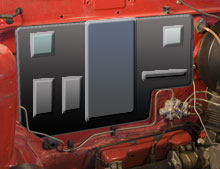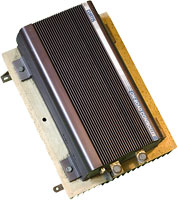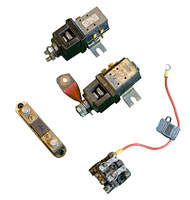Parts Placement · 23 May 06
Excuse the somewhat lame attempt at a 3D rendering using a 2D photo editing program. Let’s call it an artist’s rendition. ‘:^)
What I am working on here is a possible approach in laying out the main electronics for Eve. Last week James recommended covering all of the firewall holes with metal plugs and, just like an echo down an empty tunnel, it bounced around my mind for the rest of the evening.
Why not cover all of the firewall?
But first a quick update on batteries. Last week I emailed a bunch of folks on the EVAlbum who listed their battery type as a Deka Gel cell. The Deka’s were next on the list of battery candidates and on paper it looked pretty good.
Sure enough everyone who wrote back agreed that it was a good battery…for their purpose. The thing I had missed with each of the entries is that they were running Solectria AC drives. Jeff was good enough to explain that the Gels don’t like to put out heavy current loads (i.e. greater than 250 amps). This isn’t as big of a deal for AC drives, I guess, although I’m not completely sure why. Jeff says the controllers have more control over the max current (the Curtis has a few pots, I need to read up on what they do).
On to Plan C. Jeff said Deka AGMs are good batteries and generally cheaper than Optimas. David mentioned on the EVList that he was going to buy Powersonic PS-121000 AGMs (PDF). Again, they look pretty good on paper and Mouser has them at a quantity discount of $143 each.
Here’s something I ran across on the EVList:
A comparison:
12v Hawker Genesis AGM 70ah batteries cost over $220
12v Powersonic 100ah gel cells cost around $110
6v T-105s at 225ah run about $75 these days (at best)
Under 50amp load:
Hawker and the Powersonic AGM have about 50ah capacity
T-105 probably about 170ah
So:
12v Hawker Genesis 70ah at 50amps: 36.7cents/wh
12v Powersonic gel 100ah at 50amps: 18.3c/wh
6v Flooded T-105 225ah at 50amps: 7.4c/wh
Or, as Willie would say:
Mama don’t let your babies grow up to be converters
Don’t let ‘em pick batteries and convert them old cars
Make ‘em be doctors and lawyers and such
Mama don’t let your babies grow up to be converters
They’ll never stop tweaking and they’re always alone
Even with someone they love
Converters ain’t easy to love and they’re harder to hold
And they’d rather give you a NEV then diamonds or gold
Battery specs and old faded data sheets each night begins a new day
And if you don’t understand him and he don’t die young
He’ll just silently drive away
In the middle of all of this my wife was making calls for me based on some half remembered names that a friend of a friend’s friend got from a conversation last year regarding batteries and hospitals.
Still with me?
Way back in August Hans left a comment on Eve’s second post and suggested we check with local hospitals to see if they have recycled UPS batteries available, free or at a great discount. Since the UPS machines are used for life and death situations they tend to not wait for the batteries to die before replacing them. So, we contacted a guy who’s going to contact another guy and maybe our battery problem will go away?
In the meantime I’ve been putting the wiring back together and starting to think about doing the high voltage wiring.
Which brings us full circle back to the 3D/2D rendering at the top of the page (click to see the full sized view).
Here’s a few of the items that need to be mounted (follow along using the schematic if you like):
- Controller (20lbs?)
- Two Contactors
- Current Shunt
- A few small, 12vdc relays
- DC-DC converter
- Potbox
- Low voltage fuses and interconnects
- High voltage fuse and interconnects
On the Mazda electric car I used a hunk of MDO board (plywood with a nice, paintable surface) mounted on top of the motor and batteries. It was a horizontal mount, which meant the first time I drove uphill in a torrential downpour the electric car came to a stop.
Oh, right…
Raising the terminal blocks off the surface fixed that problem (the long term problem, the short term stall-out was fixed with a quick toweling). Still, the board took up a lot of prime real estate and made it difficult to show off the DC motor to folks.
The great thing about using MDO board? It’s wood!
My mom lives in a log cabin and whenever she wants to hang one of her paintings, put up a thermometer/spice rack/knickknack she gets out the hammer and a nail and has at it. No searching for a stud or messing with dryrock anchors, nail wherever you want.
Same goes with an MDO board for components. Non-conductive and with a nice coat of paint it can even look purty, if you are into that kind of thing.
A few of the parts to go on the board: two contactors, the shunt, and the heater relay. Another appealing aspect of the vertical mounting approach is that the wires coming from the driver’s compartment don’t have to be strung across the engine compartment and can run right to where they need to go.
That’s the plan so far.
Oh, and I have another time-lapse video coming soon.






Ah I see, you can cover your firewall holes with your controller board and maybe even sneak some wires from the controller board through the holes in the firewall to your dashboard.
I loved your ‘converter blues’. made me laugh.
I think I have seen fairly thick aluminium glued to thermosetting plastic such as bakelite. It would make a good controller board.
In reference to AC drives, they run roughly twice the voltage of a DC system, therefore all else being equal they draw half the amperage. The high voltage wiring can also be lighter gauge.
James, it's based on Waylon Jennings and Willie Nelson’s Mamma don’t let your babies grow up to be Cowboys (iTunes link). Hey, do they have country music in the UK? ”:^)
Bakelite? Like the stuff on old phones?
Thanks, Lee. That’s what I thought too. Jeff’s EVAlbum listing shows a pack voltage of 144vdc, which is what I was considering as well.
And then there was the song about converters Kenny Rogers rejected before he settled on “Don’t fall in love with a Dreamer” ;)
[cos]
I would think even better than bakelite would be a big thick piece of linen phenolic. I bet that would make a great electric substrate. Or maybe a sheet of fiberglass.
If you are still considering batteries you might find this new lithium battery interesting.
http://www.techreview.com/read_article.aspx?id=16894&ch=biztech
Jerry,
On the AC drives, the voltages are 2x to 3x what is typical of a DC system, so the peak currents will be thusly reduced.
I like your idea about component mounting! That idea would suit my plans as well – placing the controller (home made in the works) within 6” of the motor terminals. This will greatly reduce I^2 losses.
Sam’s Club sells the Exide Stowaway 6V Golf Car batteries for under $50. I’ve not seen any other batteries that come close to the price/performance of these cells for deep cycle applications. You buy Trojans, you pay a lot for the name and the middle-man dealer markup. You buy Stowaways, you pay for a good battery with little margin. Costco may also sell GC batteries in your area, with a similar price.
Not sure about the specifics of the exact usage but for anytype of instrument mounts,dont overlook plexiglass.I use it for backing and the tops of my solar panels and was so impressed with its ease of use ive started using it for a bunch of other apps that will include a s-10 conversion.Can get it from 1/8-1/2” crystalclear to black (every color inbetween) and with a dremel you can melt perfect holes in about 2 seconds.With a table saw ripping it with a 10” plastics blade is just as easy…...just a heads up.Plywood or any wood is a no-no for panels so i had to look elsewhere and found plex,my new duct tape.
Minor note: Solectria AC drives are not high voltage. The newer Forces are 156 Volts nominal, the older Forces and the pickups are 144 Volts. The Forces have a 250 Amp limit, the trucks are actually two Force setups in parallel with two battery strings in parallel so they also only go as high as 250 amps per battery. They did do some higher voltage NiMH Forces, I think they were something like 185 Volts. Yes, a 156 Volt 250 Amp EV, AC or DC, could best be described as a bit wimpy on power.
On exeptionally hot days after running 50-55mpH for 10-15 minutes I noticed that my EV loses power for a split second every 10 seconds or so. I can watch the amps drop from 200 to 0 then back again. Has anyone else seen this problem? Or know what could be causing it? (overheating controller?) I’m using a Curtis Controller with a 120VDC system.
Hi Woody. If I do similar with my Zapi controller an alarm goes off to say it’s unhappy. I guess it’s just a thermal cut out. It’s bound to have a thermal cut out.
Hi Woody—Put your Curtis controller on a heatsink, and put a fan blowing across the heatsink. This solved the same problem for me.
It’s on a heatsink with a fan already.
The schematic diagram shows 16 X 12 volts = 96Volts. Isn’t that suppose to be 16 X 6 volts?
Is it possible to pull a project like this in a year and a half? I’m doing a senior thesis project for high school and am very interested in alternate power sources (and cars).
Hi Joe,
Which schematic are you referring to?
Hi Alex,
Sure, my first one was finished in about 9 months working on it off and on.
Woody—Be sure to use heatsink compound between the heatsink and the controller. Also, be sure that you are blowing cool air across the heatsink, not air already heated by the motor or controller. (I rigged a duct to pull outside air.) Hope this helps!
Hi, Jerry I’m starting to convert a 1988 Mazda 626 5 speed. Can you help me get parts, like motor, controller,etc,etc.? Thanks Larry